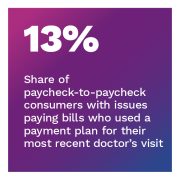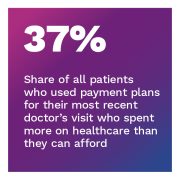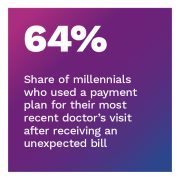Consumers Willing to Shop Around for a Doctor That Offers Patient Plans

 Despite relatively accessible health insurance options, consumers often face overwhelming out-of-pocket costs. Managing healthcare spending can be a challenge, especially for patients not expecting bills. One helpful tool is the payment plan, which enables patients to stretch out these medical expenses over time.
Despite relatively accessible health insurance options, consumers often face overwhelming out-of-pocket costs. Managing healthcare spending can be a challenge, especially for patients not expecting bills. One helpful tool is the payment plan, which enables patients to stretch out these medical expenses over time.
PYMNTS’ research finds that age and financial health are key predictors of a patient’s need for payment plans.  Patients living paycheck to paycheck are most likely to need payment plans to pay healthcare-related expenses, as are relatively younger patients. Our data revealed a connection between surprise bills and payment plans, suggesting that many patients have either limited or no room in their budgets for healthcare.
Patients living paycheck to paycheck are most likely to need payment plans to pay healthcare-related expenses, as are relatively younger patients. Our data revealed a connection between surprise bills and payment plans, suggesting that many patients have either limited or no room in their budgets for healthcare.
Healthcare providers that offer effective and user-friendly payment plans for out-of-pocket healthcare expenses not only improve the patient experience, but also strengthen their customer base. The quality of the payment plan process matters a great deal, however: Our data shows that a majority of patients who use payment plans are highly interested in switching healthcare providers for a better payments experience.
Managing Healthcare Costs: How Patients Use Payment Plans, a PYMNTS and Experian Health collaboration, examines the effects of rising costs on patient care and explores how less financially secure patients are increasingly utilizing payment plans to pay for medical treatment. We surveyed 2,483 U.S. consumers from May 26 to May 30 to learn more about how healthcare providers’ ability to provide payment alternatives drives patient satisfaction and improves care.
- Nearly one in 10 patients have used a payment plan to pay for their most recent doctor’s visit, indicating that plans are a viable option to help manage healthcare spending. Financial stability is a major factor. Payment plans seem to be serving as emergency stability for those who have exhausted their financial safety nets. While 13% of patients living paycheck to paycheck with issues paying their bills have used a payment plan, only 3% of those who do not live paycheck to paycheck have done so. Relatively younger patients, who also tend to be less financially secure, are more likely to have used a payment plan to pay for healthcare than older generations: 11% of millennials and 10% of Generation Z patients have done so, but just 2% of baby boomers and seniors have.
- Unexpected bills make patients more likely to use payment plans, suggesting that patients have limited room in their budgets for healthcare or no room at all. Fifty-two percent of patients who paid for their most recent visits with a payment plan had received an unexpected bill, indicating that paying over time is already a viable option. Yet, 64% of millennials who paid using a payment plan had received unexpected bills, compared to just 28% of baby boomers and seniors. Patients living paycheck to paycheck with issues paying their bills are significantly more likely than average to pay via a payment plan after getting a surprise bill. While 59% of those living paycheck to paycheck with issues paying bills who had received a surprise bill set up a payment plan for their most recent healthcare visits, only 13% of patients who do not live paycheck to paycheck who had received a surprise bill set up a payment plan.
 Payment plans are particularly critical for patients who are under financial distress specifically because of healthcare costs. Thirty-seven percent of all patients who used payment plans to pay for their most recent doctor’s visits spent more on healthcare than they can afford. Patients living paycheck to paycheck who paid with payment plans are not just more likely to be in financial distress generally, but also more likely to have overwhelming healthcare costs: 39% of these patients have spent more on healthcare than they can afford, compared to 28% of those not living paycheck to paycheck. Nearly half of bridge millennials and Generation X consumers who paid with plans are in financial distress due to healthcare costs — far greater than the 16% of baby boomers and seniors in the same situation.
Payment plans are particularly critical for patients who are under financial distress specifically because of healthcare costs. Thirty-seven percent of all patients who used payment plans to pay for their most recent doctor’s visits spent more on healthcare than they can afford. Patients living paycheck to paycheck who paid with payment plans are not just more likely to be in financial distress generally, but also more likely to have overwhelming healthcare costs: 39% of these patients have spent more on healthcare than they can afford, compared to 28% of those not living paycheck to paycheck. Nearly half of bridge millennials and Generation X consumers who paid with plans are in financial distress due to healthcare costs — far greater than the 16% of baby boomers and seniors in the same situation.
To learn more about how consumers are using payment plans to manage their healthcare costs, download the report.
